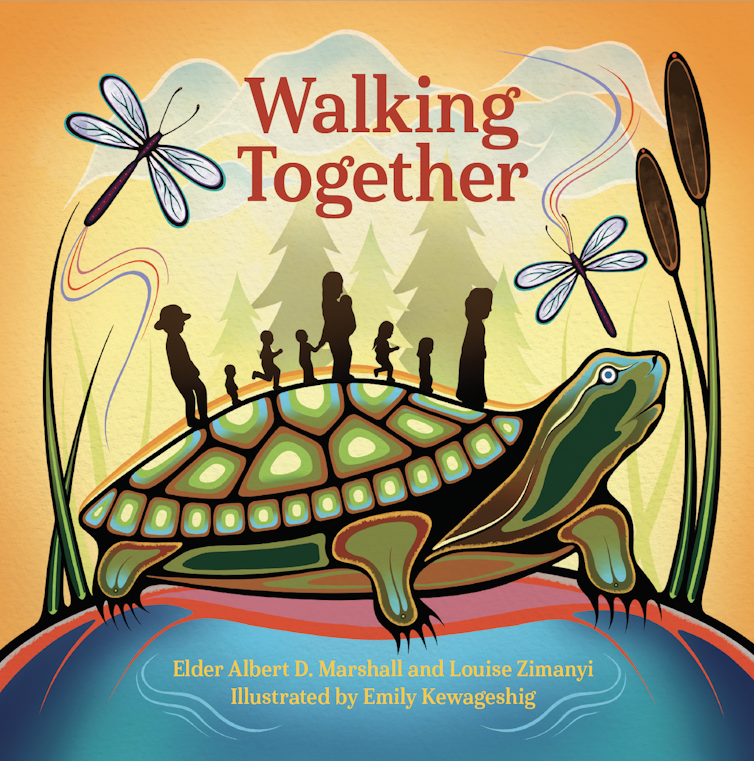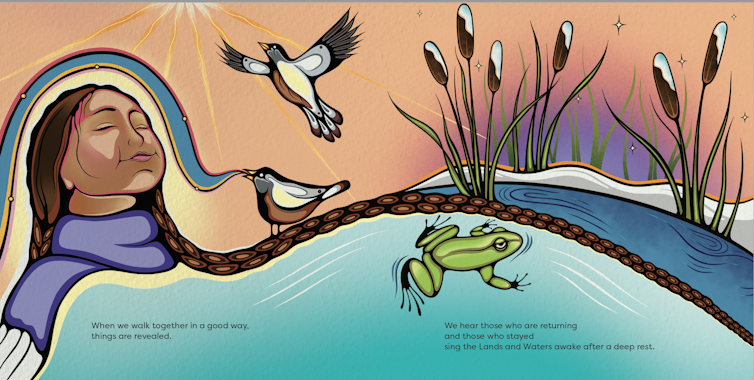
A knowledge and research collective at Humber College has been working to create, teach and evaluate a new course in the early childhood education program, Two-Eyed Land-Based Play and Co-Learning.
Etuaptmumk (eh-doo-ahp-duh-mumk) or Two-Eyed Seeing is the gift of multiple perspectives in the Mi’kmaw language.
We are Louise Zimanyi, professor and researcher of French-Canadian and Hungarian descent living as a guest in Tkaronto/Toronto, Ont., Treaty 13 territory, and Mi’kmaw Elder Albert Marshall, Moose Clan from Eskasoni, Unama’ki/Cape Breton, Nova Scotia, the territory of the Mi'kma'ki.
We are part of the Two-Eyed Land-Based Play and Co-Learning Knowledge and Research Collective and have been co-learning together since meeting in early 2020. Co-learning means enhancing each other’s understandings and perspectives, by sharing your gifts through relationships and the exchange of stories.
Two-Eyed Seeing inspired the reimagining of Humber’s nature program for young children, and is the focus of Louise’s doctoral work. Exploring children’s outdoor play through Two-Eyed Seeing led to rethinking post-secondary training for early childhood educators through this unique and timely course.
Read more: Wonder and wisdom in a children's forest nature program
With support from the Lawson Foundation, we are contributing to advancing outdoor play practice and research in early learning and child care in Canada.
Exchange of stories
Two-Eyed Seeing research embraces both Indigenous and non-Indigenous research methods. It emphasizes “the exchange of stories, the foundation of any and all relationships,” in the words of Elder Marshall. How does Two-Eyed Seeing inform an early childhood program? A key approach and practice we have explored is “walking together.”
This is also the title of a new children’s picture book we have written, illustrated by Anishinaabe artist Emily Kewageshig. The book is a result of developing meaningful and lasting relationships through sharing stories and the desire to create resources for children, families and educators.

Walking Together offers guidance on nurturing respectful and reciprocal relationships. We learn the languages of the Land: the Land takes care of us when we take care of her.
Through reconnecting to and with the Land, Two-Eyed Seeing is about learning to see from one eye with the strengths of Indigenous knowledges and ways of knowing and from the other eye with the strengths of non-Indigenous knowledges and ways of knowing. Learning to use both eyes together for the benefit of all prioritizes our eco-kin, and restores balance between natural and human worlds.
Co-learning with the Land
The course at Humber is located on and shaped by the traditional and treaty lands of the Mississaugas of the Credit and Indigenous and non-Indigenous faculty who co-teach the course. The course is supported by local and regional Indigenous Elders, Knowledge Holders, mentors and storytellers.
All who participate in the course co-learn together as they connect or reconnect to and with nature’s ecosystems through Land-based experiences, storytelling, inter-generational teachings and reflection in all seasons and weather.
Two-Eyed Seeing and walking together is inspired by the wisdom of the late Mi’kmaw Spiritual Leader and Healer Chief, Charles Labrador, of Acadia First Nation, Nova Scotia, who said:
“Go into the forest, you see the Birch, Maple, Pine. Look underground and all those trees are holding hands. We as people must do the same.”

Transforming early childhood education
In early childhood education, walking together builds on the benefits of outdoor and nature-based play that supports children’s emotional, intellectual and physical development through exploration and inquiry.
Walking together engages spirit, heart, mind and body together.
When we walk together in a good way, Frog, Stick, Water and Rock are our teachers. We learn about their gifts through our two eyes. Across Turtle Island, the stories of animal and plants will be different depending on what Indigenous Lands one is on.

In understanding that nature has rights, and we all have collective responsibilities to protect the Earth as good ancestors, the practice of walking together demonstrates that different ways of knowing can co-exist together peacefully.
Co-learning relationships are essential to rethinking and transforming early childhood education practice in response to the Truth and Reconciliation Calls to Action and Call to Action No. 12.
Seeing from another’s perspective
Two-Eyed Seeing helps us to know the environment through human eyes while also seeing things from another’s perspective. With this braided knowledge, we are enriched and transformed.
We then bear a responsibility to share what we learn and act for the benefit of all, now and for seven generations ahead.
Responsibilities to all beings
The first phase of the research at Humber has been supported by a faculty team, Maamaawisiiwin Education Research Centre and Humber’s Office of Research and Innovation, Scholarly Teaching and Learning.
Initial findings demonstrate that co-teaching and co-learning engages spirit, heart, mind and body for all learners.
As storytellers, advocates, writers and artists, we are using our gifts to enact our own and collective responsibilities to all beings.
Like the flossy milkweed flower seeds that are carried on autumn winds for future generations of monarch butterflies, these seeds of knowledge can guide, regenerate and transform early childhood education practice for the benefit of all. This is an approach that has global relevance for protecting biodiversity, climate action and resilience.
When we walk together in a good way, we learn to know the world through two eyes.
Wela'lioq, Thank you.
The authors do not work for, consult, own shares in or receive funding from any company or organization that would benefit from this article, and have disclosed no relevant affiliations beyond their academic appointment.
This article was originally published on The Conversation. Read the original article.







